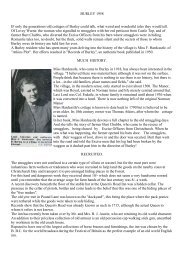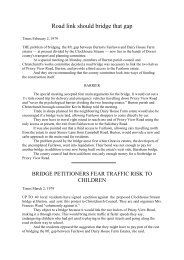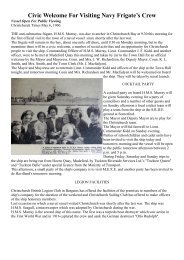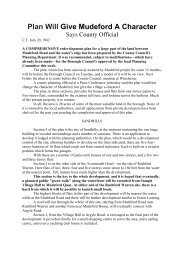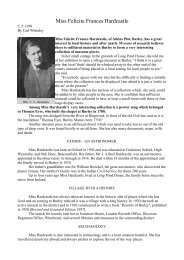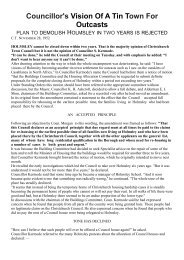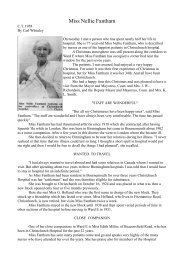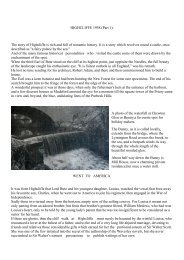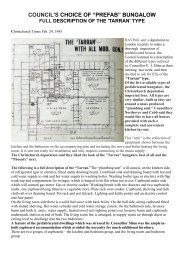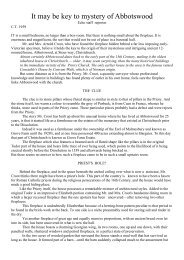Man and the Christchurch Avon 1963 - royhodges.co.uk
Man and the Christchurch Avon 1963 - royhodges.co.uk
Man and the Christchurch Avon 1963 - royhodges.co.uk
You also want an ePaper? Increase the reach of your titles
YUMPU automatically turns print PDFs into web optimized ePapers that Google loves.
LEGITIMATE<br />
During this period, however, quite an amount of legitimate <strong>co</strong>astal trade had been developed by sailing<br />
barges with cargoes of <strong>co</strong>al, <strong>co</strong>rn <strong>and</strong> timber—<strong>the</strong> 5½ ft. harbour ironstone bar <strong>and</strong> s<strong>and</strong>banks still<br />
restricting <strong>the</strong> size of ships entering <strong>the</strong> port. Customs dues, etc., were registered at Southampton—<br />
<strong>Christchurch</strong> being classed as a creek under <strong>the</strong> port of Southampton, <strong>and</strong> <strong>co</strong>al duties, etc., were paid to<br />
Southampton.<br />
A 1799 report mentions that <strong>the</strong> port was <strong>the</strong>re "limited to <strong>co</strong>astwise trade only without special permission is<br />
given". A <strong>co</strong>ast-water superintendent tended <strong>the</strong> loading <strong>and</strong> discharge of <strong>co</strong>asting vessels at <strong>Christchurch</strong><br />
Quay <strong>and</strong> <strong>the</strong>re was also a Customs <strong>and</strong> Excise riding officer. There was also a Customs <strong>and</strong> Excise cutter of<br />
100 tons with 30 men <strong>and</strong> a harbour row-boat with a superior officer <strong>and</strong> six "guardsmen".<br />
This formidable array is again some indication, not of <strong>the</strong> honest traffic of <strong>the</strong> port, but of <strong>the</strong> smuggling<br />
trade along <strong>the</strong> <strong>co</strong>ast. In 1801 a fur<strong>the</strong>r report mentions <strong>the</strong> poor state of <strong>the</strong> harbour at <strong>Christchurch</strong> <strong>and</strong> that<br />
"<strong>the</strong> quay is chiefly frequented by sloops which <strong>co</strong>nvey beer to Portsmouth <strong>and</strong> occasionally by small<br />
<strong>co</strong>asters which bring <strong>co</strong>al <strong>and</strong> limestone from <strong>the</strong> neighbouring ports".<br />
This report describes also <strong>the</strong> "two high-tides" phenomenon of <strong>the</strong> <strong>co</strong>ast here <strong>and</strong> suggests such a highwater<br />
was due to <strong>the</strong> Solent ebb via Hurst Castle holding up <strong>the</strong> water in <strong>Christchurch</strong> Bay.<br />
A RECORD<br />
No <strong>co</strong>mprehensive statistics of <strong>Christchurch</strong> trade alone seem available but <strong>the</strong>re is a re<strong>co</strong>rd of tobac<strong>co</strong><br />
being shipped from <strong>Christchurch</strong> to Weymouth in 1691.<br />
The following re<strong>co</strong>rd from <strong>the</strong> <strong>co</strong>ntemporary diary of <strong>the</strong> Riding Officer <strong>and</strong> Supervisor of Excise at<br />
<strong>Christchurch</strong> for <strong>the</strong> year 1803 shows <strong>the</strong> state of <strong>the</strong> legitimate harbour trade.<br />
Inward Bound: From Portl<strong>and</strong>: Two cargoes of stone. From Portsmouth: One cargo br<strong>and</strong>y, rum <strong>and</strong><br />
general; one cargo of wheat; one cargo of wine; five cargoes of <strong>co</strong>al; five cargoes bricks <strong>and</strong> tiles.<br />
From London: One cargo beer. From Chichester: One cargo household furniture; two cargoes wheat. From<br />
Southampton: One cargo <strong>co</strong>als <strong>and</strong> slate. From Poole: One cargo stone; three cargoes <strong>co</strong>al. From<br />
Lymington: Two cargoes of <strong>co</strong>al, tiles <strong>and</strong> bricks. Total: 26.<br />
Outward Bound: To Portsmouth: Twenty-five cargoes of beer, malt, barley, wheat; two cargoes rushes; one<br />
cargo potatoes. To Lymington: One cargo beech planks; one cargo biscuits. To Newport (I.O.W.): One<br />
cargo rushes.<br />
To Plymouth: One cargo biscuits. To London: One cargo wheat. To Newhaven: One cargo tiles; one cargo<br />
bricks. Total: 35.<br />
Whe<strong>the</strong>r <strong>the</strong> excess of exports over imports signifies "prosperity" in this case it is difficult to judge, as no<br />
details or tonnage <strong>and</strong> values are given. (The original M.S. in Red House Museum). Four small vessels<br />
"belonged to <strong>the</strong> Port of <strong>Christchurch</strong>" in 1831.<br />
LIMITED<br />
In 1851 <strong>the</strong> <strong>co</strong>astal trade of <strong>Christchurch</strong> was still limited to shallow-draught barges carrying <strong>co</strong>al, <strong>co</strong>rn <strong>and</strong><br />
timber, <strong>and</strong> any Customs dues were payable to Southampton, though a Customs <strong>and</strong> Excise Officer was still<br />
re<strong>co</strong>rded in <strong>Christchurch</strong> in 1920.<br />
<strong>Christchurch</strong> parish registers do not give help over harbour traffic but mention is made of sea disasters<br />
nearby. A signal-station was maintained at Hengistbury Head for a period during <strong>the</strong> Napoleonic Wars. In<br />
<strong>the</strong> early 1830's a fur<strong>the</strong>r effort was made by responsible citizens in <strong>Christchurch</strong> to develop <strong>the</strong> harbour<br />
<strong>and</strong> a certain John Sylvester presented a report, now in <strong>the</strong> Red House Museum. He maintained <strong>the</strong><br />
obvious points that <strong>the</strong> problems of <strong>the</strong> harbour were <strong>co</strong>nnected with <strong>the</strong> very flat <strong>co</strong>untry through which <strong>the</strong><br />
rivers pass, <strong>the</strong> small tidal rise <strong>and</strong> fall <strong>and</strong> <strong>the</strong> reflow of <strong>the</strong> tides before low water—all of which reduce<br />
s<strong>co</strong>ur.<br />
His main proposal was a practical scheme of keeping <strong>the</strong> main channel clear by making it as smooth a curve<br />
as possible to en<strong>co</strong>urage flow <strong>and</strong> s<strong>co</strong>ur by building stone embankments in places to <strong>the</strong> main channel.<br />
These ideas followed those in earlier plans (as far back as Yarranton except that he <strong>and</strong> Smeaton favoured



